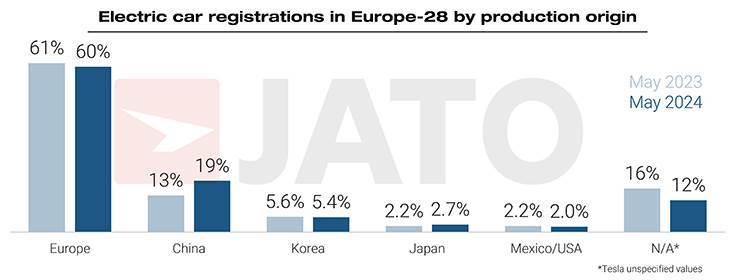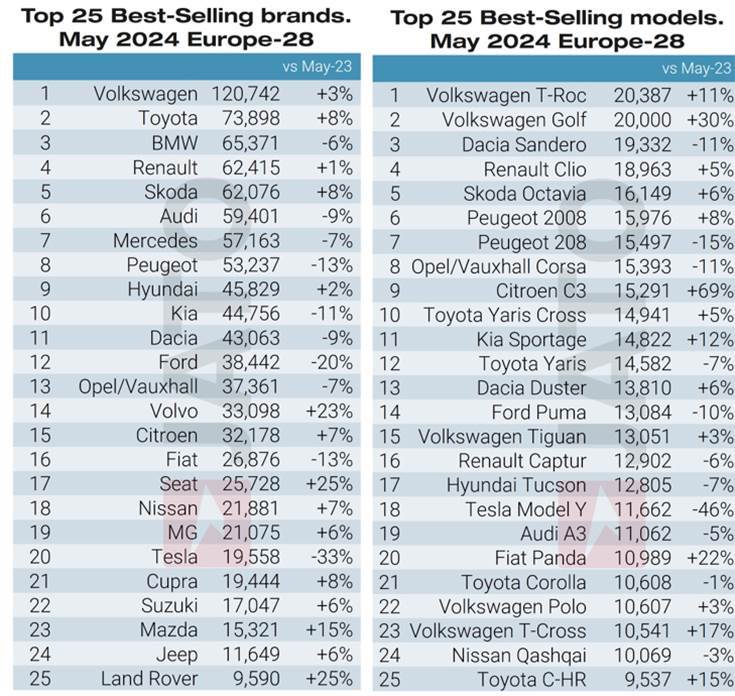After recording a 15% year-on-year increase in April 2024 (144,588 units), demand for battery electric vehicles (BEVs) in Europe fell by 9% month on month, and by 11% YoY to 151,237 units in May 2024.
According to JATO Dynamics’ data for 28 European markets, European new passenger car registrations totalled 1,087,699 units in May – a 2.5% decline compared with May 2023. However, registrations remained higher than May 2022 and 2021, when total units amounted to 943,405 and 1,082,934, respectively.

Felipe Munoz, global analyst at JATO Dynamics, commented: “Since the global pandemic, the European car market has only recovered to 75-80% of its original size. As a result, many factories across Europe are not operating at full capacity, giving Chinese OEMs a unique opportunity to sell across Europe while avoiding tariffs.”
This reduction is partly explained by a 10% decline in the registrations of battery electric vehicles (BEVs) and plug-in hybrid vehicles (PHEVs). Registrations of these vehicles dropped from 250,530 units in May 2023, to 226,665 units in May 2024. BEVs saw the largest decline in year-on-year registrations, falling 11% to 151,237 units, while PHEVs experienced a 7% decrease. According to Munoz, “This negative result comes as a result of high BEV and PHEV prices, with these cars still unaffordable for the masses.”
Despite this, some BEV models continued to perform well last month. BMW continued to gain traction with its iX1, as well as the new i5 and iX2. The brand’s BEV volume was approximately 1.6 times higher than all electric models registered by Audi or Mercedes. Volvo claimed third place amongst the top-selling BEVs both in May and year-to-date with the EX30.
 Chinese-made BEVs gain traction
Chinese-made BEVs gain traction
In May 2024, retail sales of Chinese-made BEVs rose by 25% YoY to reach almost 28,000 units. Munoz said, “The Volvo EX30 is just one example of a China-made vehicle that is doing extremely well across Europe.”
In contrast, EVs manufactured outside of China saw a 16% decline in registrations year-on-year. Munoz said that in May 2024, the market share of Chinese-made BEVs jumped from 13.2% to 18.5% year-on-year. “It’s striking that two Chinese models secured a place in Europe’s top five best-selling BEVs for May. This increase in registrations likely comes in anticipation of the impending European Commission tariffs.”
Volvo, BYD, and Smart saw the most significant increases in BEV registrations, while MG, BMW, Dacia, and Polestar all lost ground. MG’s ICE offering outperformed its BEVs, with volume increasing by 47% in May, and by 61% since the start of the year. Munoz added: “MG is turning its attention to non-electric cars to maintain ground in Europe. This is likely a response to the European Commission’s probe and incoming tariffs. For instance, in January-May 2023, it registered almost an equal number of electric and combustion cars. A year on, its volume of ICE cars is nearly double that of its BEV registrations.”
The Volkswagen Golf registered 20,000 units in May, becoming the second most-registered car, behind the Volkswagen T-Roc. The Golf’s volume increased by 30%, driven by higher fleet and business registrations, securing second place in the overall model ranking year-to-date. Other notable models last month included the Citroen C3, supported by deals on its previous generation. The Cupra/Seat Leon, Toyota RAV4, Seat Ibiza, Opel/Vauxhall Astra, and Jeep Avenger also posted strong YoY growth. Among new models, the Volvo EX30 performed well in May, with more than 7,500 units registered.
Other notable players included the Lexus LBX with over 2,100 units; the BMW i5 with almost 2,000 units; the new Renault Scenic with 1,631 units; and the Mercedes CLE with 1,581 units. Fiat registered 1,515 units of the 600; Volkswagen registered 1,239 units of the ID.7; BMW registered 1,144 units of the iX2; the Mitsubishi Colt registered 1,058 units; and the Renault Rafale and Omoda 5 registered 1,003 and 797 respectively.
 Data charts: JATO Dynamics
Data charts: JATO Dynamics
